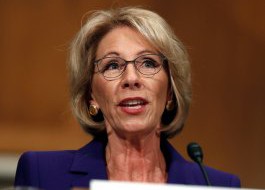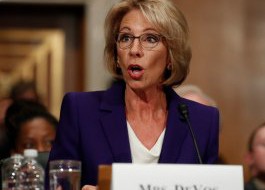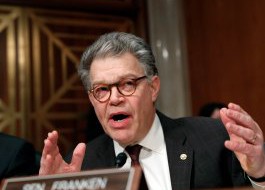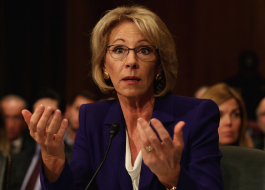 Betsy DeVos. Yuri Gripas/Reuters
Betsy DeVos. Yuri Gripas/Reuters
The Senate confirmed Betsy DeVos as the secretary of education on Tuesday in historic fashion, requiring Vice President Mike Pence to cast the tiebreaking vote.
The Senate split 50-50, with every Democratic senator and Republican Sens. Susan Collins of Maine and Lisa Murkowski of Alaska voting to oppose DeVos. It was the first time in US history that a vice president has had to cast a tiebreaker vote for a Cabinet nominee.
The vote ended an uncharacteristically contentious confirmation process for a secretary of education. The position is typically confirmed without major opposition.
So what exactly does the secretary of education do?
Education in the US is largely under state and local control, and the federal government's role is limited in scope.
As the head of the US Department of Education, the secretary advises and executes legislation over education policy at both the K-12 and postsecondary levels.
"The position of secretary of education is, more than anything, an opportunity to be a bully pulpit to express the views of the president," Paul Reville, a professor at the Harvard Graduate School of Education, told Business Insider. "The role is highly constrained."
Created in 1979 under President Jimmy Carter, the Education Department is the smallest Cabinet-level department. Its main functions include administering federal assistance to schools and enforcing federal education laws. The secretary of education is No. 15 in line to succeed the president.
Before it became an independent agency, the Education Department existed under the scope of what is now known as the Department of Health and Human Services — formerly the Department of Health, Education, and Welfare.
A changing political and social environment after World War II led to the creation of the department as interest in investing in the American educational system increased. The Soviet Union's launch of Sputnik in 1957, for example, pushed the US on its heels and started the race to close the perceived gap in technological capabilities between the USSR and the US.
Today, the department collects data and does research on student outcomes and success, providing national figures that allow for comparison among states.
While school districts get most of their funding from local taxes, federal agencies including the Education Department contribute about 8% to district budgets. The department's Title I program, for example, provides funding to schools with large numbers of low-income students.
The department, through its Office for Civil Rights, also handles matters related to discrimination in schools and colleges on the basis of race, gender, sexual orientation, and other characteristics.
 Former Secretary of Education Arne Duncan. Thomson Reuters
Former Secretary of Education Arne Duncan. Thomson Reuters
For example, the American Civil Liberties Union filed a complaint with the Department of Education in 2014 on behalf of Gavin Grimm, a transgender student who said he was discriminated against by his school district because it did not let him use the bathroom that corresponded with his gender identity.
And in 2015, an alliance of Asian-American groups filed a complaint with the department against Harvard University, saying Harvard and other Ivy League schools used racial quotas that discriminated against Asians in their admissions processes.
The Office for Civil Rights is also responsible for investigating violations of Title IX, the federal law that prohibits discrimination based on gender in education. The Education Department currently has more than 200 open investigations into sexual assaults on college campuses.
One of the largest — and certainly the costliest — areas of responsibility for the department is administering federal student aid. The department spent about $22.5 billion in fiscal 2016 on the Pell Grant program, which provides aid for students that does not need to be repaid. The program was the largest area of spending for the department in 2016.
In her home state of Michigan, DeVos has championed charter school and school-voucher initiatives, but she has not waded into issues of higher education. She is the first choice for secretary of education without substantial experience in higher education.
While it's possible to predict some of the issues related to primary and secondary schooling that DeVos will support in her role, the direction she will take in higher education is less apparent. During a confirmation hearing where DeVos was grilled on several issues, she gave vague answers or said she was currently unable to provide a response.




